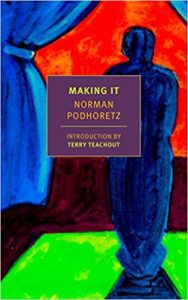Many conservatives who follow politics came to know Norman Podhoretz through his work as the editor of Commentary and his own essays, most of which were published in Commentary itself. He moved notably from the left to the right, shed friends and influenced many people like me along the way. He could write the book on How To Lose Friends and Influence People, and more or less has under other titles.
But Podhoretz came of age in the Age of Criticism, as John Crowe Ransom called it. Having distinguished himself as a star student of Lionel Trilling at Columbia and F.R. Leavis at Cambridge, Podhoretz quickly made a name as a critic and essayist in the fifties. He made a splash in particular with a dissenting review of Saul Bellow’s Adventures of Augie March.
Podhoretz never abandoned criticism entirely, but the center of gravity in his work shifted toward politics and culture. The Bloody Crossroads (1986) collects his essays combining his literary and political interests.
The Age of Criticism has yielded to the Age of Autobiography. Podhoretz has made his own contribution in four autobiographical volumes. Three of these books form a trilogy in which Podhoretz presents himself as a case study: Making It (1967), Breaking Ranks (1979) and Ex-Friends (1999). The fourth of his autobiographical volumes is My Love Affair With America (2000). Each of these books makes an invaluable contribution to the history of our times.
In Making It Podhoretz chronicled his rise in the world of New York intellectuals. Although Frederic Raphael’s review in the New York Times made for an honorable exception, the book was trashed upon its publication in late 1967.
I read the book as a literarily inclined teenager in 1968. Meeting Midge Decter (Mrs. Podhoretz) at a small get-together with her old friends in St. Paul in the fall of 1968 — Midge and my mom had been high school friends and my mom let me tag along with her — I was vaguely aware that something bad had happened to the book. Midge was then executive editor of Harper’s Magazine under Willie Morris. She was herself a principal in the world of New York’s literary politics at the time. When I asked Midge about the book, she shrugged and sighed: “Oh, it’s water under the bridge.”
Today is the official publication date of Making It in an attractive new paperback edition with an introduction by Terry Teachout. The new edition is published by New York Review Books as a NYRB Classic. Thereby hangs a tale. With a little help from Thomas Jeffers’s excellent biography of Podhoretz, I try to tell the tale in the City Journal column “If Making It can make it there.”
The book surely went over my head after the first chapter when I read it in 1968. This time around, however, I found myself in awe. Podhoretz was operating at the height of his very great powers in the book. In the fullness of time Making It now takes its place in the great tradition of American autobiography.
NOTE: I have adapted this post from one I wrote last month to observe the publication of the new edition of Making It today.

Notice: All comments are subject to moderation. Our comments are intended to be a forum for civil discourse bearing on the subject under discussion. Commenters who stray beyond the bounds of civility or employ what we deem gratuitous vulgarity in a comment — including, but not limited to, “s***,” “f***,” “a*******,” or one of their many variants — will be banned without further notice in the sole discretion of the site moderator.